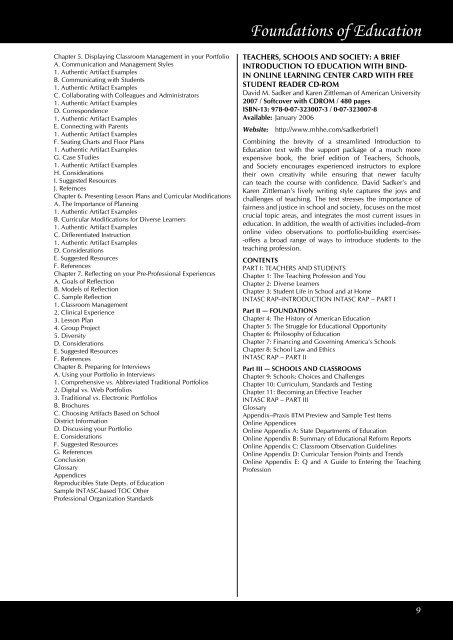table of contents - McGraw-Hill Books
table of contents - McGraw-Hill Books
table of contents - McGraw-Hill Books
You also want an ePaper? Increase the reach of your titles
YUMPU automatically turns print PDFs into web optimized ePapers that Google loves.
Foundations <strong>of</strong> Education<br />
Chapter 5. Displaying Classroom Management in your Portfolio<br />
A. Communication and Management Styles<br />
1. Authentic Artifact Examples<br />
B. Communicating with Students<br />
1. Authentic Artifact Examples<br />
C. Collaborating with Colleagues and Administrators<br />
1. Authentic Artifact Examples<br />
D. Correspondence<br />
1. Authentic Artifact Examples<br />
E. Connecting with Parents<br />
1. Authentic Artifact Examples<br />
F. Seating Charts and Floor Plans<br />
1. Authentic Artifact Examples<br />
G. Case STudies<br />
1. Authentic Artifact Examples<br />
H. Considerations<br />
I. Suggested Resources<br />
J. Refernces<br />
Chapter 6. Presenting Lesson Plans and Curricular Modifications<br />
A. The Importance <strong>of</strong> Planning<br />
1. Authentic Artifact Examples<br />
B. Curricular Modifications for Diverse Learners<br />
1. Authentic Artifact Examples<br />
C. Differentiated Instruction<br />
1. Authentic Artifact Examples<br />
D. Considerations<br />
E. Suggested Resources<br />
F. References<br />
Chapter 7. Reflecting on your Pre-Pr<strong>of</strong>essional Experiences<br />
A. Goals <strong>of</strong> Reflection<br />
B. Models <strong>of</strong> Reflection<br />
C. Sample Reflection<br />
1. Classroom Management<br />
2. Clinical Experience<br />
3. Lesson Plan<br />
4. Group Project<br />
5. Diversity<br />
D. Considerations<br />
E. Suggested Resources<br />
F. References<br />
Chapter 8. Preparing for Interviews<br />
A. Using your Portfolio in Interviews<br />
1. Comprehensive vs. Abbreviated Traditional Portfolios<br />
2. Digital vs. Web Portfolios<br />
3. Traditional vs. Electronic Portfolios<br />
B. Brochures<br />
C. Choosing Artifacts Based on School<br />
District Information<br />
D. Discussing your Portfolio<br />
E. Considerations<br />
F. Suggested Resources<br />
G. References<br />
Conclusion<br />
Glossary<br />
Appendices<br />
Reproducibles State Depts. <strong>of</strong> Education<br />
Sample INTASC-based TOC Other<br />
Pr<strong>of</strong>essional Organization Standards<br />
TEACHERS, SCHOOLS AND SOCIETY: A BRIEF<br />
INTRODUCTION TO EDUCATION WITH BIND-<br />
IN ONLINE LEARNING CENTER CARD WITH FREE<br />
STUDENT READER CD-ROM<br />
David M. Sadker and Karen Zittleman <strong>of</strong> American University<br />
2007 / S<strong>of</strong>tcover with CDROM / 480 pages<br />
ISBN-13: 978-0-07-323007-3 / 0-07-323007-8<br />
Available: January 2006<br />
Website: http://www.mhhe.com/sadkerbrief1<br />
Combining the brevity <strong>of</strong> a streamlined Introduction to<br />
Education text with the support package <strong>of</strong> a much more<br />
expensive book, the brief edition <strong>of</strong> Teachers, Schools,<br />
and Society encourages experienced instructors to explore<br />
their own creativity while ensuring that newer faculty<br />
can teach the course with confidence. David Sadker’s and<br />
Karen Zittleman’s lively writing style captures the joys and<br />
challenges <strong>of</strong> teaching. The text stresses the importance <strong>of</strong><br />
fairness and justice in school and society, focuses on the most<br />
crucial topic areas, and integrates the most current issues in<br />
education. In addition, the wealth <strong>of</strong> activities included--from<br />
online video observations to portfolio-building exercises-<br />
-<strong>of</strong>fers a broad range <strong>of</strong> ways to introduce students to the<br />
teaching pr<strong>of</strong>ession.<br />
CONTENTS<br />
PART I: TEACHERS AND STUDENTS<br />
Chapter 1: The Teaching Pr<strong>of</strong>ession and You<br />
Chapter 2: Diverse Learners<br />
Chapter 3: Student Life in School and at Home<br />
INTASC RAP--INTRODUCTION INTASC RAP – PART I<br />
Part II — FOUNDATIONS<br />
Chapter 4: The History <strong>of</strong> American Education<br />
Chapter 5: The Struggle for Educational Opportunity<br />
Chapter 6: Philosophy <strong>of</strong> Education<br />
Chapter 7: Financing and Governing America’s Schools<br />
Chapter 8: School Law and Ethics<br />
INTASC RAP – PART II<br />
Part III — SCHOOLS AND CLASSROOMS<br />
Chapter 9: Schools: Choices and Challenges<br />
Chapter 10: Curriculum, Standards and Testing<br />
Chapter 11: Becoming an Effective Teacher<br />
INTASC RAP – PART III<br />
Glossary<br />
Appendix--Praxis IITM Preview and Sample Test Items<br />
Online Appendices<br />
Online Appendix A: State Departments <strong>of</strong> Education<br />
Online Appendix B: Summary <strong>of</strong> Educational Reform Reports<br />
Online Appendix C: Classroom Observation Guidelines<br />
Online Appendix D: Curricular Tension Points and Trends<br />
Online Appendix E: Q and A Guide to Entering the Teaching<br />
Pr<strong>of</strong>ession<br />
9

















